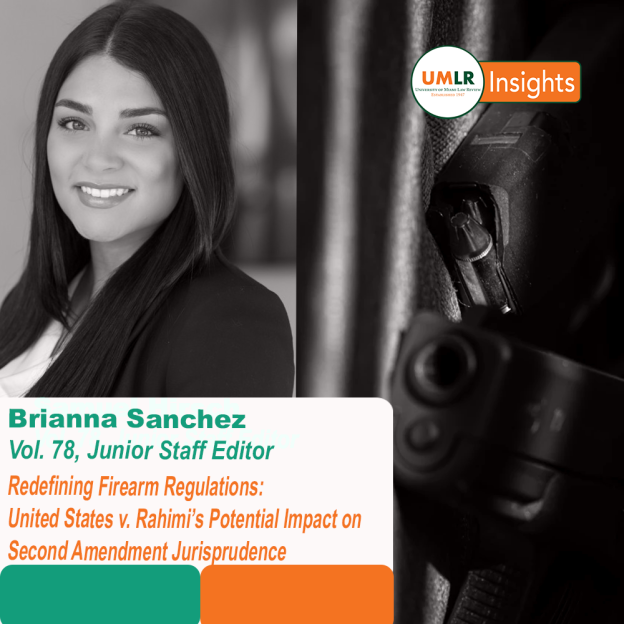BRIANNA SANCHEZ—In the coming months, the United States Supreme Court will issue an opinion of profound significance: whether 18 U.S.C. § 922(g)(8), which prohibits the possession of firearms by persons subject to domestic violence restraining orders, violates the Second Amendment to the Constitution. The case, United States v. Rahimi, is located at the intersection of constitutional law and public safety and explores the boundaries of the Second Amendment—the right “to keep and bear Arms.” However, this case does not exist in a vacuum; in fact, it is part of a broader legal landscape and is intrinsically linked to two other landmark cases: United States v. McGinnis and New York State Rifle & Pistol Association v. Bruen. McGinnis, decided by the Fifth Circuit Court of Appeals in 2020, grapples with the constitutionality of federal laws prohibiting individuals subject to domestic violence restraining orders from possessing firearms; whereas Bruen, decided by the Supreme Court in 2022, examines state laws regulating concealed carry permits for firearms. Both cases have left indelible imprints on Second Amendment jurisprudence and will undoubtedly influence the outcome of United States v. Rahimi.
In 2019, following a domestic dispute in a public parking lot, Zackery Rahimi’s girlfriend filed a restraining order against him. That restraining order, granted in 2020 and valid for the following two years, included a suspension of Rahimi’s handgun license and prohibited him from possessing any kind of firearm. The order also warned Rahimi that possessing a firearm while the order remained in effect may constitute a federal felony punishable for up to ten years of imprisonment. Despite Rahimi’s signed acknowledgment of these terms, between December 2020 and January 2021, Rahimi participated in five shootings. This violation resulted in police executing a search warrant on his home, ultimately leading to the recovery of two firearms. Consequently, Rahimi was indicted under 18 U.S.C. § 922(g)(8). Although Rahimi attempted to dismiss the indictment against him under the Second Amendment, the district court denied the motion citing McGinnis as foreclosing any argument regarding the constitutionality of 18 U.S.C. § 922(g)(8).
When deciding McGinnis, the appellate court looked to United States v. Emerson to determine whether 18 U.S.C. § 922(g)(8) violated the Second Amendment on its face. Emerson acknowledged that while Second Amendment rights are sacrosanct, that “does not mean that those rights may never be made subject to any limited, narrowly tailored specific exceptions or restrictions . . . .” To define the boundaries of “narrowly tailored specific restrictions,” Emerson created a two-step inquiry. First courts consider “whether the conduct at issue falls within the scope of the Second Amendment right.” To fall “within the scope of the Second Amendment,” courts look to the history and tradition of Second Amendment application. If the restriction is consistent with the Amendment’s history and tradition, it is deemed constitutional and the inquiry concludes. However, if it is inconsistent, the analysis proceeds to the second step. At this point, courts must “determine and ‘apply the appropriate level of means-ends scrutiny’—either strict or intermediate.” In deciding which level of scrutiny applies, courts evaluate: (a) “the nature of the conduct;” and (b) “the degree to which the challenged law burdens the right.” Should a court determine that intermediate scrutiny applies, the court must then ask whether the law is “reasonably adapted to an important government interest.”
In McGinnis, the court refrained from determining whether the keeping and possessing of firearms by individuals subject to a domestic violence protective order fell within the scope of the Second Amendment. Rather, the court focused only on step two of the Emerson test, the means-end scrutiny inquiry. The court concluded that § 922(g)(8) merited intermediate scrutiny as it pertained to a “discrete class of individuals,” those under domestic violence restraining orders, and was “temporary in nature,” only in effect during the active period of the order. The law thus survived intermediate scrutiny analysis, primarily because it was “reasonably adapted to an important government interest.” As stated by the Fourth Circuit in United States v. Mahin, “§ 922(g)(8) rests on an established link between domestic abuse, recidivism, and gun violence and applies to persons already individually adjudged in prior protective orders to pose a future threat of abuse.”
Although McGinnis seemingly foreclosed the argument regarding the constitutionality of § 922(g)(8), the Fifth Circuit withdrew its initial opinion in Rahimi’s case following New York State Rifle & Pistol Association v. Bruen. In Bruen, the Supreme Court was tasked with deciding the constitutionality of a New York law that conditioned a concealed carry permit on a showing of “proper cause.” In making this determination, the Court openly rejected the two-part inquiry developed by Emerson and focused only on whether the statute was consistent with “the Second Amendment’s text and historical understanding.” The Court first relied on District of Columbia v. Heller in considering whether the plain text of the Second Amendment covers an individual’s conduct. In this case, both parties conceded that the scope of the Second Amendment covers law-abiding citizens and the right to self-defense. The Court then looked to see whether the regulation was consistent with the history and tradition of firearm regulation. By engaging in this inquiry, the Court determined that the conduct at issue—New York’s proper-cause requirement for concealed carry permits—was inconsistent with history and tradition. As a result, the restriction was deemed unconstitutional.
Thus, the Supreme Court, in adjudicating United States v. Rahimi, will face a critical decision between two distinct tests: the means-end scrutiny test established in McGinnis and the history and tradition test set out in Bruen. The Court’s decision will reverberate across the legal landscape, influencing legislation and societal norms surrounding gun ownership and use.






